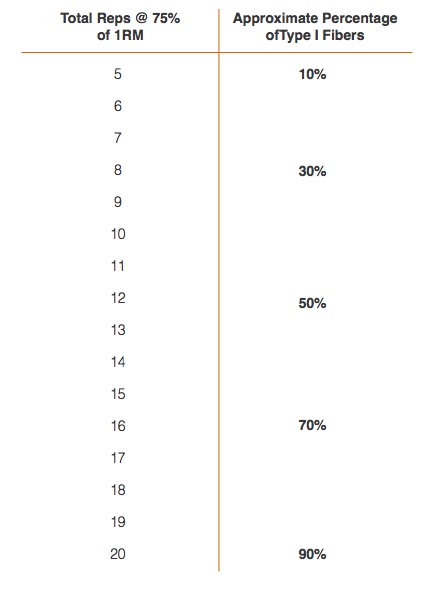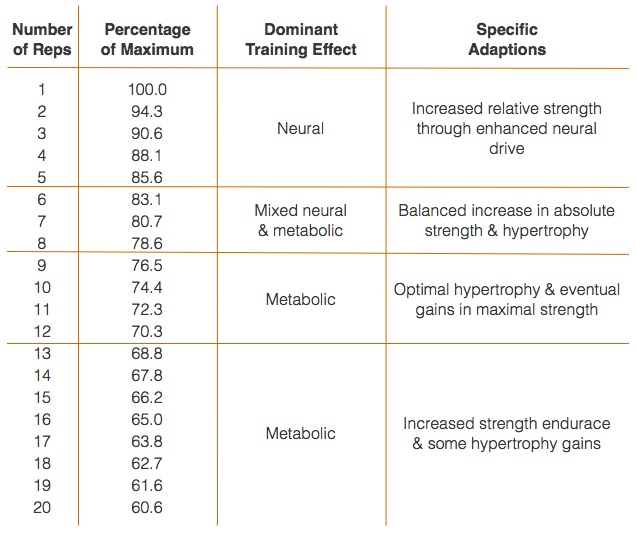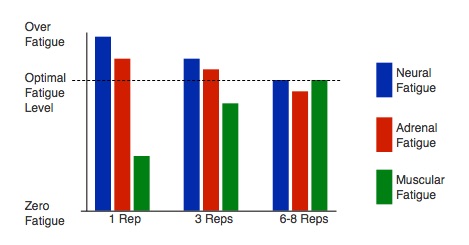A repetition is best defined in strength training as one full cycle of the contraction modes involved. This cycle may consist of the following:
1. Eccentric phase or eccentric contraction
2. Stretch phase or (eccentric) pause
3. Concentric phase or concentric contraction
4. Contracted phase or (concentric) pause.
The continual repetition cycle of the 4 components listed above combine to produce a set.
A repetition may start in the eccentric phase or the concentric phase depending on the specific exercise or how the exercise it set up to be performed for a specific purpose. An example would be the Bench Press when under normal circumstances the repetition would start at the top of the movement in the eccentric phase of the movement however the Bench Press performed inside a power rack with the safety bars set to chest height then the movement would start in the concentric phase and would produce a different outcome.
It has been suggested by some authors that the number of repetitions is the single most important exercise variable (Poliquin, 1989). However with the complexity of exercise variables in strength training it would be premature to suggest any one exercise variable to be the most important.
The amount of weight you lift in relation to your one-repetition maximum (1RM) determines how much tension a muscle produces.
1RM refers to one repetition maximum, which is the weight that can be lifted for a single repetition only. Percentage of the 1RM is the basis of the Repetition Continuum and determines the intensity being applied. The amount of weight you lift in relation to your one-repetition maximum (1RM) determines how much tension a muscle produces and may be a critical factor in obtaining a strength or hypertrophy response.
The Repetition Continuum
Repetitions can be viewed along a continuum showing the dominant adaptations and related loading.
 The Repetition Continuum vs Training Effect
The Repetition Continuum vs Training Effect
The relationship between repetitions and training methods
The relationship between repetitions and training methods is shown in the table below. Note that everyone has the potential to react in a different manner depending of factors such as genetics, muscle fiber composition, training age, chronological age.
The table below is just a guideline and where it may suggests that 8-12 repetitions will be best for hypertrophy doesn’t mean that at any given time with any individual that will be the most effective option.
Determining Muscle Fiber Composition
Determining muscle fiber composition may play an important role in the selection of repetition ranges to produce a specific outcome.
Below is a method of approximating muscle fiber composition:
1. Determine your 1RM (1 Repetition Maximum) for any given exercise.
2. Calculate 75% of the 1RM.
3. After an adequate rest, use the 75% 1RM load and perform as many reps as possible using the same technique.
4. Take the number of reps performed and compare to the table below to calculate your approximate percentage of slow twitch fiber (Type I) composition.
This method of calculating your percentage of slow twitch fibers tends to be a little more accurate with individuals with at least 12 months training experience.

Specificity in Repetitions

There will be times to ignore the above table. These times may include:
1. Novice – Advanced training experience
2. As part of a long term periodization plan
3. Individualized response to training (individualization)
Training Age Influences the Repetition Continuum
Training age or the number of years an individual has been participating in a serious strength training program can influence the Repetition Continuum. The reps performed for a novice with a 1 year training age could perform 20 reps with a 75%RM where someone with 4 or more training years may only be able to perform 5 repetitions at 75%RM.
Repetitions and Gender
Women can generally perform a greater number of repetitions at any percentage 1 rep maximum (1RM, or one repetition maximum).
Repetitions Dictate Training Effect
Reps along with tempo dictates time under tension that then dictates the training effect. Lower reps generally means higher loads can be utilized and therefore higher intensity (%1RM).
Exercise Selection and Reps
Some exercises are best suited towards a specific repetition bracket such as the case with Olympic Lifting. Generally 1-5 reps are used in the Olympic Lifts while other exercises such as squats and bench press could be used for a larger range of repetitions from 1 to 20 (or even higher).
Metabolic to Neural
The method of progression from metabolic to neural should be followed in strength training. This progression applies to the multi-year plan, the annual plan, and also within the microcycle. This method also allows variety into the training while also allowing the opportunity for the connective tissue to adapt to the new stress being place upon them.
Repetitions and Volume Relationship
Volume is a major factor to consider when designing a program. Total repetition volume can be influenced by increase the number of sets or the number of repetitions per set. Both can have totally different outcomes depending on other program design variables such as intensity, tempo, and rest periods.
Variety in Repetitions
Variety in repetitions may allow an unexpected adaptation from repetition bracket utilized. This could be due to over-reliance on a single repetition bracket to match the individual’s goal. For example an individual that is training for hypertrophy and has spent considerable time training in the traditional repetition bracket of 8-12 repetitions may find changing the repetition bracket being used to either a higher or lower repetition bracket may experience further hypertrophy. This can also be applied when the individual’s goals are strength based or even muscular endurance based.
Repetitions and Recovery
Sets of 1-3 reps put great stress on both the neuromuscular and neuroendocrine systems; they are therefore best used for short periods and only by those clients for whom you have qualified.
Note that the endocrine systems needs time to recuperate too, otherwise the client may experience adrenal depletion, and this can result in adrenal fatigue. Adrenal fatigue is any decrease (but not failure) in the ability of the adrenal glands to carry out their normal functions.
Bones, joints, and other connective tissues are also heavily stressed with high intensity training and may be injured with over exposure to intense loads.
The graph below demonstrates the effect on the neural, adrenal, and muscular systems caused by high intensity training.

